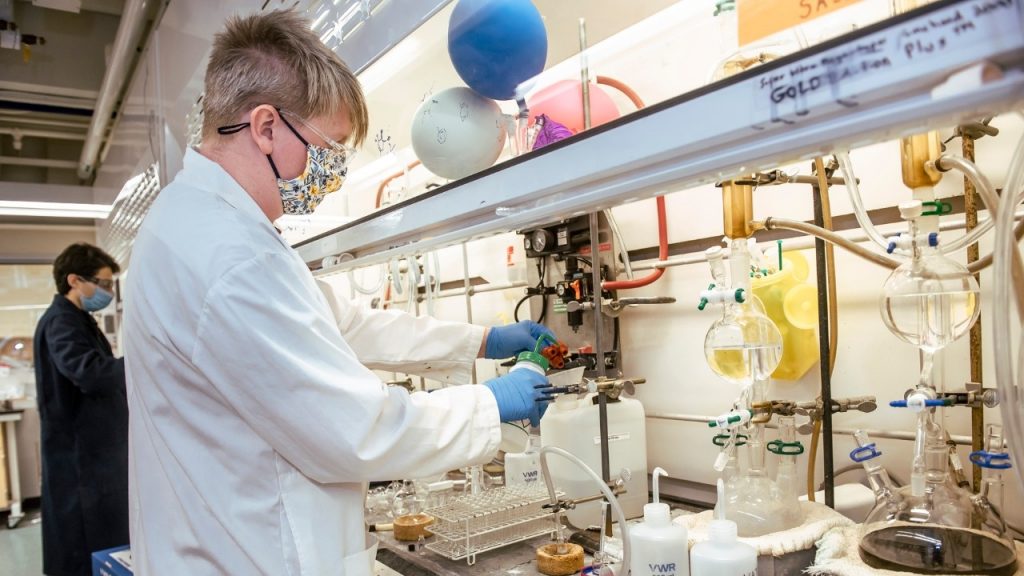From “energizing” to “yikes!”: Faculty members talk about their return to in-person teaching
Nov 30, 2021

Fall 2021 saw the resumption of predominantly in-person learning and teaching at SFU. For instructors, it signified a return to familiar classrooms and labs, but also the need to navigate yet another transition during a time of continuous change.
We recently asked five faculty members to describe their return to in-person teaching in one word.
Kathleen Burke, a university lecturer in the Beedie School of Business, said the experience was “energizing.”
Taco Niet, an assistant professor in the School of Sustainable Energy Engineering, chose “surreal.”
Leanne Johnson, a lecturer in the Master of Publishing Program, gave us “yikes!”
Ash Parameswaran, a professor in the School of Engineering Science, said it “felt really good” (we were flexible with our word count).
And Kevin Lam, a senior lecturer in the Department of Biological Sciences, offered us a choice: “That’s a tough one … maybe ‘worthwhile’ or ‘meaningful’?”
The range of answers was not surprising. The COVID pandemic persists, various public health measures are still in place, and life has by no means returned to “normal” either on or off campus.
Yet these faculty members were able to identify teaching highlights that stood out amid all the uncertainty—and in many cases those highlights were related to a renewed sense of connection with their students.
“I really understood how much the students and I had missed meeting face-to-face when I had a small group activity in my first class,” said Leanne Johnson. “The students were so excited to be together. Some of us were almost overcome by the joy of that moment … It was fantastic. Best group activity ever.”
Kathleen Burke pinpointed one element of teaching that she had missed during remote instruction: “Seeing expressions in every student’s eyes and body language. So much of remote instruction left instructors ‘in the dark’ as we rely quite heavily on non-verbal feedback from students to gauge and modify our teaching practices.”
For Kevin Lam, the renewed connections extended beyond the classroom: “[I loved] having students and colleagues drop by to catch up, chat, and go for walks outside. I’ve really missed these warm and real interactions.”
The biggest challenges
Like any other transition, the return to in-person instruction has required adaptations and adjustments.
For Ash Parameswaran, the process was straightforward: “I did not face any challenges. The transition was fairly smooth.”
But several faculty members identified student stress and logistical issues related to the pandemic as special concerns.
Kathleen Burke described the scene in her classroom: “The masks enable us to be together in learning, but they also create a barrier—for example, ‘Will I be heard?’ [or] ‘Will my voice sound different?’
“We returned to a campus fundamentally altered by the pandemic, which adds a layer of worries and pressures on top of the demands associated with learning generally.”
Leanne Johnson agreed. “We are seeing students who are experiencing extreme stress, and this impacts everyone in the class. We have had to be more flexible and understanding.”
And it isn’t just the students.
Kevin Lam candidly identified his greatest challenge as “being tired.”
“It’s been almost two years now of constant adaptation—of planning ahead, then changing the plans to adapt to new situations and needs as they evolve. In some ways it’s exciting to try new things and to connect and interact with students in new ways, and it’s satisfying to feel growth and learn from students what does and doesn’t work in each new normal. But the feeling of running on fumes has become a new normal for me, both physically and mentally, and that’s tough.”
“After” will not be the same as “before”
All five faculty members said their in-person teaching has changed as a result of their experience with the pandemic and remote instruction.
“It’s mostly small shifts rather than anything major,” said Taco Niet, but he has noticed one significant change. “I think I’m more compassionate when students ask for academic concessions.”
Ash Parameswaran found that his online teaching experience gave him time to explore new approaches: “Remote teaching gave me some ideas on how to teach laboratory material, and I am making use of that knowledge in my face-to-face teaching. Also, remote teaching allowed me to explore different ways of conducting exams, and that also I am implementing in the face-to-face class exams.”
For Kathleen Burke, “teaching in the remote environment highlighted the importance of clear and consistent communication. I have carried that lesson back into the in-person environment. I am now much more intentional in my messages, instructions and feedback to students.”
Leanne Johnson and Kevin Lam have made student well-being an even greater focus of their teaching approaches.
“I’ve been trying to find new ways to cut back on how complex and busy my courses are to give everyone, especially my students, a bit more time and space to breathe,” said Lam.
“After two and a half semesters of teaching online, I learned that I need to centre student wellness into the course design,” echoed Johnson. “So I reconsidered every component of my courses from the viewpoint of how it would support or detract from student well-being. This is something I continue to do in my face-to-face classes as well.”
If there’s a silver lining to the turmoil of the past year and a half, it can be found in those actions and in the compassion and creativity demonstrated by so many of our wonderful instructors at SFU.
